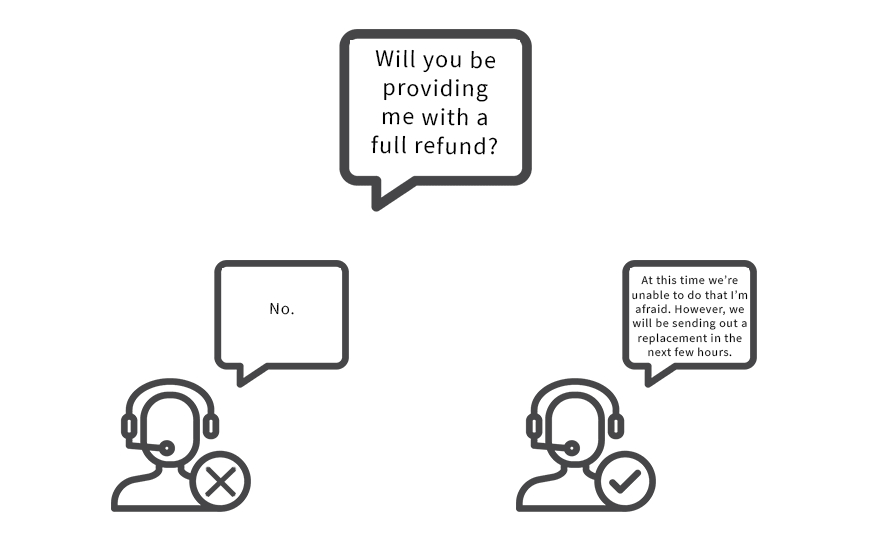Being an effective trainer is probably the closest thing you can have to a superpower as a contact centre manager.
With just the flick of the tongue, you can turn average agents into awesome communicators, enabling your team to achieve incredible outcomes – all without having to go through the rigmarole of hiring new staff!
Sadly, it’s not always that easy. But before you go and complete a call centre management course, we’ll outline some best practices and training techniques you can use to get the most out of your team.
Contents
The basics
First, let’s discuss some of the basic training best practices you should know about as a call centre manager.
New employee induction

This is where it all kicks off – every employee starts at step one, when they first come on board with your team. As a result, it’s important to get off on the right foot, and equip each new team member to have a long, successful stint at your contact centre.
Somewhat surprisingly, new employee induction can be one of the simplest parts of your training processes, if you get the right structures in place.
Why is this?
- You know (for the most part) exactly where an employee’s at. You’ve just completed a thorough check of their employment history and experience, so you should have a good idea of their current skillset.
- The new agent is unlikely to have any idea of how you run your specific call centre. Therefore, you can begin at ground zero for every new hire, and make this part of the induction process pretty much the same for each person.
- It’s clear exactly when this sort of training has to occur: when the new agent starts. You may feel the need to give certain employees refreshers over time, but we’ll get to that a little later on.
Creating an induction process

Different call centres will have different ways of doing this. For example, if you’re in customer service, it’s definitely worth taking a week or two to educate the employee about the specifics of your product. This may seem like a large amount of time, but the investment is nearly always worth it in the long run.
Start by thinking about what the new hire needs to know to be able to complete their job. Create specialised booklets or PDFs with instructions for dealing with certain situations (like customer escalations), how to use your call centre software, techniques for dealing with gatekeepers and anything else you deem necessary.
You can then quiz employees on this information to assess their level of knowledge. It’s generally best to avoid formal tests though since you’re trying to keep things interesting.
Remember: your customer-facing product information may be filled with material that it simply isn’t necessary for your team to understand. Don’t just tell agents to study the website – condense the relevant information down and add more pertinent material that will enable them to do their job to the best of their ability.
If it’s important that the rep gets things right from the very first call, you can then move on to one-on-one training. Play some sample call recordings, and discuss what the agent on that call did well, as well as where they could improve.
If your new hire already has a heap of contact centre experience in your particular industry, it might be worth giving them the freedom to learn more quickly. For example, letting them take live calls early on and then providing constructive feedback on their conversations as a part of the induction process.
Mentorship

Depending on the sorts of call volumes you’re dealing with and the number of agents you manage, you might not have the time to spend an entire month helping your new agent get acquainted with your setup.
Instead, you can pair them up with one of your most experienced employees – pick someone enthusiastic about helping others. The mentor’s job is to answer any questions the new agent may have, and provide constructive support where necessary.
It’s generally best to avoid having a set induction period (two weeks for example) due to the lack of flexibility this offers. More experienced agents might pick up on things more quickly, while others may need a little bit longer before starting to take live calls. Make the process feel natural – beginning a new job can be quite stressful, even for seasoned experts.
Your attitude towards improvement

As we discussed in our guide to call centre management, your attitude as a supervisor/manager is crucial. This is because employees rely on you to help them improve. If you’re open to questions and provide helpful, constructive answers, agents are going to be much more likely to ask you for help.
Ultimately, you (or your supervisors) want to be bombarded with questions, to a certain extent. When you get asked something, this is essentially an agent telling you what they need help with. If you get questions constantly, this removes an incredible amount of the guesswork from creating training processes.
However, these have got to be the right questions – ones which are actually worth your time to respond to. You don’t just want to be enabling lazy agents. Point your reps in the direction of your self-help documentation where necessary.
Fortunately, ensuring that you’re displaying the right attitude is relatively straightforward.
Ask yourself:
- How often is my help/advice specifically requested?
- Who is it that’s approaching me regularly? Some employees will be more outgoing than others, but it’s important that a wide range of people are seeking your advice.
- Are agents willing to come forward when an important call doesn’t go as intended and ask how they could improve?
Once you’re in the position where your team isn’t afraid to raise anything they’d like to discuss, you can then begin to note down the issues they’re bringing up. Over time, you can use this data to identify patterns and produce better training programs to drive continuous improvement.
Developing further insights

As a call centre manager, you likely have limited time/money allocated towards training your staff. So how do you determine where the best-possible places are to focus your limited resources?
Like we just discussed, you can eliminate a lot of the guesswork by having employees come to you, allowing you to identify potential areas of improvement. However, this relies on your team being incredibly well-motivated to continually improve their own performance.
Luckily, there are other ways to uncover these insights without having to rely on agents approaching you.
Metrics and KPIs
What better way to measure performance than to actually look at the stats?
It’s no good just having a heap of metrics and no idea what to do with them though. You need a way of producing actionable insights which can be used to improve your training techniques.
For example, you can compare the conversion rates of different team members, to identify those who may be underperforming and those doing exceptionally well. You can also look at first-contact resolution by agent or even by each category of product you sell, to find out what information agents could benefit from reading up on.
Voice analytics

The issue with relying solely on KPIs is while they can identify areas of improvement, sometimes they won’t tell you exactly what’s causing the problem. This is where voice analytics comes in.
Essentially, this software processes call data, analysing the tone, pitch, pace, and volume of the words spoken. It can then help you identify what’s working and what isn’t with regards to what your agents are saying, and how they’re saying it.
With this information, you can then optimise conversational techniques, and train agents to make the best-possible calls each and every time. For example, you might find that leads are less likely to convert if an agent spends more than 30 seconds talking uninterrupted. You would then instruct your team to give their contacts a little more opportunity to talk.
Quality assurance
Another tried-and-tested method of finding the quick-and-easy areas for improvement is your quality assurance (QA) module.
While speech analytics can do this process automatically, it works just as well (albeit a bit more slowly) with a human QA agent. Simply load up the calls, pick quality criteria, and check to ensure that things are going smoothly.
If there’s room for improvement (like if agents aren’t always greeting customers/leads correctly) then creating a training program to remedy the issue is a fairly simple task.
Keeping up with industry best practice

The slight limitation with the methods of developing insight we’ve discussed so far is they’re incredibly internalised. Meaning, you’re comparing agent-to-agent performance, or period-to-period performance. But how do you know how you’re doing in relation to the broader contact centre industry?
To keep ahead of the curve, it’s worth taking the time to check LinkedIn/Twitter on occasion.
If possible, it’s also a good idea to attend the latest industry expos. We love to go to these events – they’re a great way of broadening your network and finding people you can rely on for advice.
In Australia, Auscontact holds regular state conferences, and the Customer Contact Network New Zealand also runs an annual get-together.
Here are some training best practices you can begin implementing today:
- Encourage your reps to empathise with the customer. Get them thinking about why the person is calling you, and what their needs are.
- Use real-world examples to teach techniques. Having knowledge of your product is all well and good, but you’ve also got to use real-world examples to train agent decision-making. Whether it be conversation recordings or feedback once an agent has completed a call, getting the technique down is absolutely crucial. This is where mentorship comes in handy – experienced agents can share secrets that managers might not even know.
- Avoid negative language. In broad terms, your team’s job is to provide a solution to the caller – whether this be a new product or help with an existing one. As a result, reps have to bend over backwards to help the contact if you’re to achieve the outcomes you’re after. Meaning, it’s best to avoid words like “no”, “can’t” and “won’t” where you can help it. Instead, train agents to explain their way around difficult questions.

Training methods
Now that you’ve identified where your team could improve, you’ll need to create effective training regimes based on this information.
The most fundamental thing to consider for each specific training program is whether you’re going to be helping individual agents or your entire team at once.
Individual training

One-on-one feedback can be incredibly powerful. However, it has to be done right.
Although this isn’t likely to be an easy thing to achieve, your ultimate goal should be to develop a library of techniques employees can use in-call to help them make better decisions.
To do this, you need to provide feedback quickly, while the agent still has the call at the front of their mind. Help them to understand how they could have done better, for example, approaching the gatekeeper a different way, not selling the product so soon or explaining concepts differently.
It’s important that you don’t try to provide advice when there was genuinely nothing the rep could have done to increase the chances of a positive outcome. This is because you want your feedback to be memorable – if there’s too much information, a lot of it will be missed.
As you continue doing this, your agents should learn to associate future call situations with the feedback you gave them the last time this happened, enabling them to avoid making the same mistake twice.
Targeted performance improvement

You can also accelerate this process if you’re not often finding the opportunity to provide such feedback naturally.
Ask an agent to make a post-call note of how they could have done better for the next 5 calls that they make. Then, listen to the recordings (or listen to them together) and provide your thoughts. This way, you’re still providing feedback on real-world situations, but you can make this happen at any time, without having to wait for the opportunity to provide targeted advice.
Group training
While informal one-on-one discussions are a great way to get specific agents on the right path, there’s always a place for more formal group sessions to train reps more efficiently.
Here are some techniques you can use to make things interesting and ensure that the knowledge really sets in.
Gamification

Sometimes when training staff it can seem like information is going in one ear and straight out the other. But why does this happen?
It could be because you’re simply not making the learning process interesting enough. Boring classroom sessions are now being thrown out in favour of more engaging ways of training staff.
One way to spice things up is gamification.
- First, give your team material they can study at their own pace in booklets or PDF documents. Sit them down and explain concepts on a whiteboard if necessary.
- Then, rather than testing their knowledge with a pen and paper, hold a make-believe game show in your office. You could play a quick version of Who Wants to be a Millionaire, or if you’re feeling up to it, do The Weakest Link. Make the questions relatively easy, and only include ones which have black and white answers. The game doesn’t have to work perfectly – as long as it’s fun, it’ll go a long way towards helping with knowledge retention while also having the added benefit of being an effective team-bonding exercise.
Role-play

This method is particularly popular in the airline industry, as it forces hosts and hostesses to think on their feet and come up with responses quickly. Your agents are going to have to do the same thing (albeit not in person), which is why role-playing exercises can be worth trying.
Pick a supervisor, manager, or experienced agent – ideally someone who fancies themselves as an actor. Their job is to play the role of the angry customer or difficult-to-get lead. Prepare them with objections you commonly encounter or issues your customers raise which agents often struggle to deal with. Then, stage a fake call with an agent.
The issue with doing this in a group setting is unless everyone’s incredibly serious, it’s easy for the two people to get distracted by their audience. If you like, use one of your best agents to demonstrate the techniques you want to train. You could act as a director – occasionally pausing the conversation to explain why the rep chose to use the language they did.
Another way to go about doing this is to film a highly-scripted conversation, edit and annotate the video, and then show it to your staff. Even the most basic visual learning can be a really effective way of delivering information.
Train versatility

You’re never going to be able to prepare each and every agent for every call they’ll ever make or receive.
Instead, you can train them to be quick on their feet – this is part of what games and role-playing aim to achieve. By doing this, you’ll not only be saving a heap of time, but better-preparing agents to deal with tough situations.
Apart from role-playing, you can:
- Focus on broad, widely-applicable techniques. Like avoiding negative language, and empathising with the customer’s concerns.
- Train agents how to find the information they need, and quickly.
- Encourage predictive thinking – getting the agent to think about where a call may be heading (particularly inbound) based on the initial information received. This can be difficult to teach – experienced agents normally pick it up over time.
Keep sessions short
This is especially important if you’re trying to explain concepts to employees – you need to minimise the time spent telling, and maximise the time spent doing if you want to ensure that agents remember what you tell them.
If you’ve got a lot of material to cover, or upper management have allocated an entire day to training, you’ll need to mix things up to keep it interesting.
- Have morning tea/lunch/snack breaks.
- Use different mediums of learning – practical demonstrations, videos, whiteboard explainers, talks from experienced agents (or even customers), Q&A sessions and quizzes are some examples. Interactive activities are the best way of maximising engagement.
- Mix up different content. If you have a really long topic to cover, do half in the morning and the second half in the late afternoon with unrelated content in between.
Figure out what each training session aims to achieve

The worst type of training is pointless training, especially in a call centre environment. Remember, every second a rep spends learning they could be spending talking.
To figure out if a training session is really worth doing, answer the following questions:
- Have we taught agents about this specific skill/subject in the past 6 months? Were we successful, or would revisiting the topic make sense?
- What will agents take away from this meeting/training session?
- How will this newfound knowledge enable them to achieve better outcomes on-call?
Don’t be afraid to bin ideas that just aren’t worth the time.
Focus on your supervisors
If you do figure out that a certain training idea just isn’t worth doing, it could be worth teaching supervisors or managers and getting them to pass their knowledge along. Training line-managers can be a more efficient way of continually improving group performance on an ongoing basis – especially if these supervisors are great at their job.
For example, you could send them on external man-management courses, or reinforce the benefit of providing actionable insights.
You may also like to think about setting up (or refining existing) supervisor dashboards to ensure that only the most relevant information is displayed. Provide some guidance as to how this data can be used to improve performance, as sometimes it isn’t as straightforward as spotting abnormally high wrap times.
Think about your software

Chances are, if you employ more than 10 full-time reps, you’ve already invested in a contact centre software solution.
If you haven’t, get your skates on! Using Excel and/or a softphone/PABX becomes really inefficient as you scale up. Contact us and we’ll sort you out. ?
The sad truth is that some managers don’t get the most out of their software.
Whether it be underutilising features you’re paying for, a lack of understanding of the optimal settings to use, or misuse of the data analysis tools on hand, you need to make sure you’ve got to grips with the software. If you’re unsure whether you’ve got area for improvement, contact your provider’s customer success team for a catch-up.
Once you’re sure that you know the platform inside-out, you’ll be in a good position to pass on your knowledge to agents.
In this day and age, your software (and how you use it) is a critical factor in determining how successful your contact centre is. Ask yourself:
- Are agents logging data correctly? Is everything being entered in the right place, and in the right format? If it isn’t, you may be losing out on valuable insights when it comes to producing reports.
- Do your reps understand the information on offer to them on their dashboard?
- Are agents aware of how to navigate your CRM (if necessary) and find the data they need?
The more intuitive your solution, the less you’ll need to worry about this type of training. For example, contactSPACE customers have access to a facility called CallGuides®, which pull record-specific data from your CRM and place it on the agent interface – no need to navigate to any other screen/window to find the information necessary to complete an awesome call.
Conclusion

Don’t be afraid to give new hires live calls. The benefit of being thrown in the deep end often outweighs the cost, unless you’re dealing with high-value leads.
Also, depending on how many agents you have, you may be able to create split tests to figure out the best training techniques to use. Try one technique with one group, and a different method with another group. Then, assess how each session went and decide which technique was the most effective.
When considering your investment in training, ask yourself what would cost more to your organisation: a well-trained employee leaving your firm, or a poorly-trained employee staying on your team for an extended period of time.
In almost all cases, the second option is by far the most expensive outcome.
